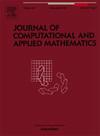Effects of higher order discretization on the predictions of steady turbulent airflow in human respiratory system
IF 2.1
2区 数学
Q1 MATHEMATICS, APPLIED
Journal of Computational and Applied Mathematics
Pub Date : 2025-02-26
DOI:10.1016/j.cam.2025.116593
引用次数: 0
Abstract
This study aims to evaluate the efficiency and accuracy of two distinct numerical schemes, the first order upwind scheme and the second-order central scheme with Van Leer limiter for convective terms, in predicting steady turbulent airflow in human airways for different flow rates ( ). A 3D model of the human respiratory system, extending from the oral cavity to the trachea and incorporating a simplified lung model (with branches from the 4th to 7th generations merged into larger funnels), is used to simulate steady inhalation and exhalation, excluding nasal tract respiration.
Through a series of simulations and subsequent analysis of the results, this study mutually compares the performance of the two numerical schemes in terms of their assumed accuracy, convergence, and computational efficiency with reference to available experimental data.
This study has shown significant differences in numerical predictions of respiratory flows obtained by first and second order schemes, pointing out that the second order approximation not only offers a potentially more accurate results, but also lower computational cost.
高阶离散化对人呼吸系统稳定湍流气流预测的影响
本文旨在评价两种不同的数值格式,即一阶迎风格式和对流项具有Van Leer限制的二阶中心格式,在预测不同流速(Q=15,30,60[l min−1])下人体气道内稳定湍流气流的效率和准确性。一个人体呼吸系统的3D模型,从口腔延伸到气管,并结合了一个简化的肺模型(从第4代到第7代的分支合并到更大的漏斗中),用于模拟稳定的吸入和呼出,不包括鼻道呼吸。通过一系列的仿真和对结果的分析,结合现有的实验数据,比较了两种数值格式在假设精度、收敛性和计算效率方面的性能。本研究显示了一阶和二阶格式在呼吸流量数值预测上的显著差异,指出二阶近似不仅可能提供更准确的结果,而且计算成本更低。
本文章由计算机程序翻译,如有差异,请以英文原文为准。
求助全文
约1分钟内获得全文
求助全文
来源期刊
CiteScore
5.40
自引率
4.20%
发文量
437
审稿时长
3.0 months
期刊介绍:
The Journal of Computational and Applied Mathematics publishes original papers of high scientific value in all areas of computational and applied mathematics. The main interest of the Journal is in papers that describe and analyze new computational techniques for solving scientific or engineering problems. Also the improved analysis, including the effectiveness and applicability, of existing methods and algorithms is of importance. The computational efficiency (e.g. the convergence, stability, accuracy, ...) should be proved and illustrated by nontrivial numerical examples. Papers describing only variants of existing methods, without adding significant new computational properties are not of interest.
The audience consists of: applied mathematicians, numerical analysts, computational scientists and engineers.

 求助内容:
求助内容: 应助结果提醒方式:
应助结果提醒方式:


